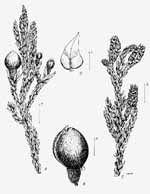 "A. branchlet with ripe fruit, B. ripe fruit, C. branchlet with male cones, D. microsporophyll" (2).
| Dacrycarpus compactus (Wasscher) de Laubenfels 1969Common NamesBinban (Oriomo), djasiha (Asaro, Kefamo), kadzinam, kaibigl (Minj), kaipik (Kubur, Minj), man (Kunimaipa), ma-u (Najo), pau (Enga, Kepilam), pawa (Enga, Poio), uba, umba, umbwa (Chimbu, Waimambano) (2, 3).Taxonomic notesSyn: Podocarpus compacta Wasscher 1941; P. papuanus (non Ridley) Pilger 1936 (2, 3).DescriptionTree: Height 2-20 m and dbh 25-60 cm, often with 'straggly and twisted' crown (2, 3).Bark: Outer bark hard, rough, warty, dark gray, cracking into small scales; inner bark reddish straw (2). Leaves: Dark green or dark grey green above, glaucous below. On primary shoots spreading slightly, often curved so that the apex is directed inward towards the axis. Leaves of juvenile foliage shoots are not distichous, lanceolate, strongly keeled laterally, 2-2.5 × 0.6 mm. Leaves on older trees not dimorphic, bifacially flattened, slightly spreading, lanceolate, falcate, needle-tipped, strongly keeled on the dorsal side, 1-2.5 × 0.6-1 mm (2, 3). Cones: Terminal on a 6-17 mm long brachyblast. Involucral leaves robust, 4-5 × 0.8-1.2 mm, clasping the receptacle, strongly keeled on the dorsal side and more or less triangular in cross section, 4-5 by 0.8-1.2 mm. Ripe receptacle purple to black, small, 3-4 mm long, warty (2, 3). Pollen cones: Lateral on a 3+ mm long shoot or terminal, cylindric, 7-8 × 2-3 mm. Microsporophylls lanceolate, 2 mm long, acute, anther-cells globose-ellipsoid, c. 1 mm long (2). Seeds: Dark brown or black, globose, 7-8.5 × 7-8 mm, with a rounded crest (2, 3). RangeNew Guinea, "[i]n subalpine shrubberies and alpine grasslands, 3200-3800 m. Flowers May - Aug., but also reported from February." Regionally distributed as follows:"TNG. Mt Capella, Mt. Scorpio, Yobobos area, Upper Korn valley, Mt Kinkain, Mt Wilhelm and lakes area, Mt Kerigomna, Mt Otto, Mt Piora, Mt Amungwiwa. "PAPUA. Mt Dickson, Mt Strong, Mt Albert Edward" (2). "Common on the higher peaks near the tree line, sometimes forming pure stands or emerging above a subalpine shrubbery, or scattered in alpine grassland, often in isolated specimens and obviously fire-resistant, in Podocarpus-Libocedrus forest, rarely on wet peaty soil (Lake Aunde), 2800-3950 m, but mostly above 3400 m." (3). Big TreeOldestDendrochronologyEthnobotanyObservationsRemarksCitations(1) Silba 1986.(2) Van Royen 1979. (3) de Laubenfels 1988. |
[Dacrycarpus] [Podocarpaceae] [home] This page is from the Gymnosperm Database |